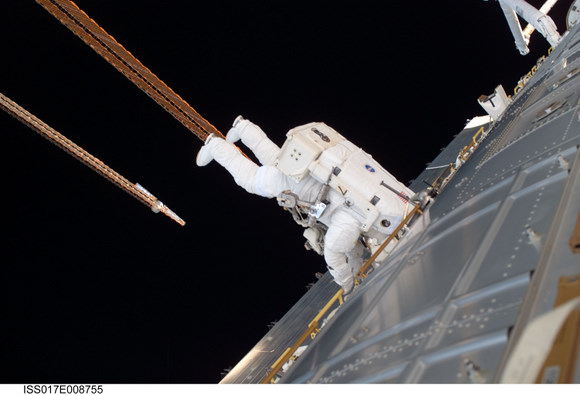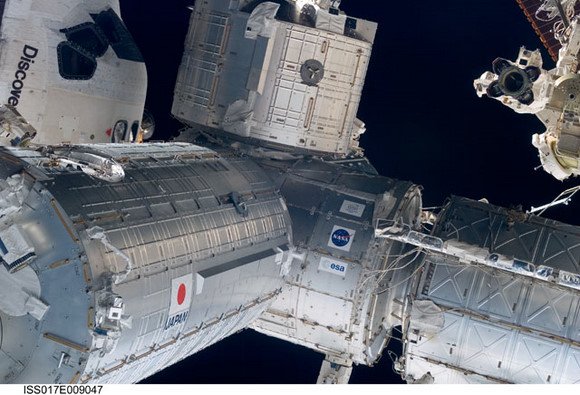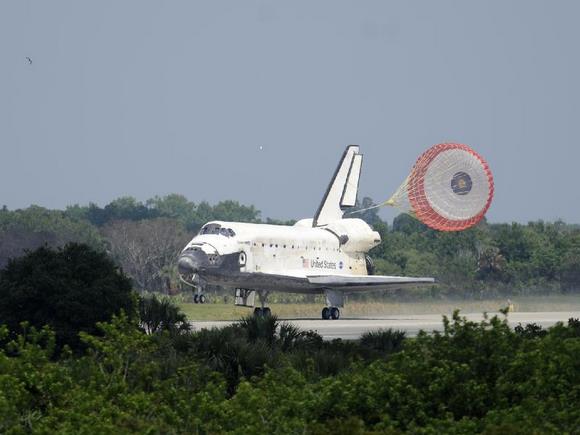Always a beautiful sight, the space shuttle Discovery touched down safely at 11:15 a.m. EDT, on Saturday, June 14, 2008, at the Kennedy Space Center in Florida. During the 13-day mission, Discovery and the crew of STS-124 delivered the new component Kibo, the Japanese Experiment Module, to the International Space Station. Mission managers say Discovery looks to be in good shape following the mission, and the crew is doing well, too. Even Garrett Reisman, who spent over 90 days on the ISS, joined the rest of the crew in walking around on the runway and surveying the shuttle. After a successful mission, its always fun to look back at some of the great images, so here’s a few…

Astronaut Ron Garan, STS-124 mission specialist, participates in the mission’s first EVA to get ready to add the Kibo Japanese Pressurized Module to the space station.

That’s two domes and two space helmets. Mark Kelly (right), STS-124 commander, and Garrett Reisman, assist astronauts Mike Fossum (left) and Ron Garan in the Quest Airlock of the International Space Station to help them get ready for an EVA.

A good look at two of the ISS solar arrays, which provide power to the station.

The ISS keeps growing, and with the addition of the Kibo lab, its actually getting pretty spacious on board the station.

The crew of the ISS took this image of the shuttle as it departed from the station, showing the now empty payload bay.

And likewise, the shuttle crew took this image of the ISS, showing the new configuration with Kibo now part of the station.

And here’s where it all started: the launch of Discovery on May 31, 2008.
See all the images from the mission here.


The picture of the ISS solar arrays doesn’t look real!
For some reason, that second photo makes me want to yell “Incoming!”
We’re almost there.. Really looking forward to project Constellation starting in earnest.
Wow what an enormous waste of money and time.
Is there a bigger version of the solar array pic? It’s incredible!
It’s not really an enormous waste of money and time because it’s all done in a studio. You didn’t think they were really in space, did you?
The money really goes towards the alien project, which will provide us with cheap, renewable energy and advanced technology in the near future. So it’s actually good value.
I love these forums… 😉
Steve
They could have lofted this entire thing with just a few Saturn V flights. Shutting down the Saturn assembly line was one of the biggest mistakes of the era. They had plans for SRB augmentation, a recoverable first stage, a lengthened first stage, the whole nine yards. I grieve for what may have been.
All the photos and more are downloadable in larger sizes at the link at the end of the article.
Hey, Greg Dinardi, I agree with you 100%. The shuttle idea was a cool idea, but we were not ready for it.
i hope the upcoming spacecraft will bring about a new era in space exploration, and it should.
Steve,
[The money really goes towards the alien project, which will provide us with cheap, renewable energy and advanced technology in the near future.]
Not to mention those tasty alien burgers, yum yum!
About one of the PIONEERS… who invented among others the RAMJET engine concept…
Eugen Sänger
(September 22, 1905 – February 10, 1964) was an Austrian-German aerospace engineer best known for his contributions to lifting body and ramjet technology.
Early career
Sänger was born in Preßnitz in Bohemia, at that time part of the Austro-Hungarian Empire. He studied civil engineering at the Technical Universities of Graz and Vienna. As a student, he came in contact with Hermann Oberth’s book Die Rakete zu den Planetenräumen (“By Rocket into Planetary Space”), which inspired him to change from studying civil engineering to aeronautics. He also joined Germany’s amateur rocket movement, the Verein für Raumschiffahrt (VfR – “Spaceflight Society”) which was centered on Oberth.
Sänger made rocket-powered flight the subject of his thesis, but it was rejected by the university as too fanciful. He was allowed to graduate when he submitted a far more mundane paper on the statics of wing trusses. Sänger would later publish his rejected thesis under the title Raketenflugtechnik (“Rocket Flight Engineering”) in 1933. In 1935 and 1936, he published articles on rocket-powered flight for the Austrian journal Flug (“Flying.”) These attracted the attention of the Reichsluftfahrtministerium (RLM, or “Reich Aviation Ministry”) which saw Sänger’s ideas as a potential way to accomplish the goal of building a bomber that could strike the United States from Germany (the Amerika Bomber project).
Sub-orbital bomber concept
Sänger agreed to lead a rocket development team in the Lüneburger Heide region in 1936. He gradually conceived a rocket-powered sled that would launch a bomber with its own rocket engines that would climb to the fringe of space and then skip along the upper atmosphere – not actually entering orbit, but able to cover vast distances in a series of sub-orbital hops. This remarkable design was called the Silbervogel (“Silverbird”) and would have relied on its fuselage creating lift (as a lifting body) to carry it along its sub-orbital path. Sänger was assisted in this design by mathematician Irene Bredt, whom he married. Sänger also designed the rocket motors that the space-plane would use, which would need to generate 1 meganewton (224,809 lbs) of thrust. In this design, he was one of the first to suggest using the rocket’s fuel as a way of cooling the engine, by circulating it around the rocket nozzle before burning it in the engine.
By 1942, the Reich Air Ministry canceled this project along with other more ambitious and theoretical designs in favour of concentrating on proven technologies. Sänger was sent to work for the Deutsche Versuchsanstalt für Segelflug (DFS, or”German Gliding Research Institute”). There he did important work on ramjet technology until the end of World War II.
Postwar
After the war ended, Sänger worked for the French government and in 1949 founded the Fédération Astronautique. Whilst in France, he was the subject of a botched attempt by Soviet agents to win him over. Stalin had become intrigued by reports of the Silbervogel design and sent his son, Vasily, and scientist Grigori Tokaty to convince him to come to the Soviet Union, but they failed to do so. It has also been reported that Stalin instructed the NKVD to kidnap him.[1].
In 1951, he became the first President of the International Astronautical Federation.
By 1954, Sänger had returned to Germany and three years later was directing a jet propulsion research institute in Stuttgart. Between 1961 and 1963 he acted as a consultant for Junkers in designing a ramjet-powered space-plane that never left the drawing board. Sänger’s other theoretical innovations during this period were proposing means of using photons for interplanetary and interstellar spacecraft propulsion, including the solar sail.
He died in Berlin. His work on the Silbervogel would prove important to the X-15, X-20 Dyna-Soar, and ultimately Space Shuttle programs.
KE:)
I am glad to have our space junkies back! I am always nervous about their return trip and it will be sad when the retire the flying bricks for good but no matter what they fly we always enjoy a safe return home! WTG STS-124! Great pics too!